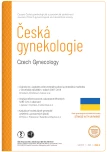Assisted reproduction in patients with Klinefelter syndrome
Authors:
K. Crha 1; M Ješeta 1; Radovan Pilka 2; M. Kašík 3; L. Mekiňová 1; J. Vodička 2; Tomáš Crha 1
Authors‘ workplace:
Gynekologicko-porodnická klinika LF MU a FN Brno
1; Porodnicko-gynekologická klinika LF UP a FN Olomouc
2; Urologická klinika LF MU a FN Brno
3
Published in:
Ceska Gynekol 2022; 87(2): 133-136
Category:
Review Article
doi:
https://doi.org/10.48095/cccg2022133
Overview
Objective: The goal of this article is to present the current knowledge of Klinefelter syndrome and its impact on male reproductive function as well as the current treatment options. Methods: PubMed/Medline, WoS and Scopus were searched for articles indexed until November 2021. Text: Klinefelter syndrome is a chromosomal aberration with an additional X chromosome in males. This may adversely affect testicular growth and spermatogenesis, thus resulting in male infertility. Recently, new knowledge has appeared about the treatment of male infertility. Conclusion: Interdisciplinary approach enables early diagnosis and treatment of patients with Klinefelter syndrome. Assisted reproductive technology is essential for infertility treatment in patients with Klinefelter syndrome.
Keywords:
genetic testing – assisted reproduction – Aneuploidy – disorders of spermatogenesis – male sterility – Klinefelter syndrome
Sources
1. Morris JK, Alberman E, Scott C et al. Is the prevalence of Klinefelter syndrome increasing? Eur J Hum Genet 2008; 16 (2): 163–170. doi: 10.1038/sj.ejhg.5201956.
2. Kamischke A, Baumgardt A, Horst J et al. Clinical and diagnostic features of patients with suspected Klinefelter syndrome. J Androl 2003; 24 (1): 41–48.
3. Zitzmann M, Aksglaede L, Corona G et al. European academy of andrology guidelines on Klinefelter syndrome endorsing organization: European Society of Endocrinology. Andrology 2021; 9 (1): 145–167. doi: 10.1111/andr.12 909.
4. Lanfranco F, Kamischke A, Zitzmann M et al. Klinefelter‘s syndrome. Lancet 2004; 364 (9430): 273–283. doi: 10.1016/S0140-6736 (04) 166 78-6.
5. Tüttelmann F, Gromoll J. Novel genetic aspects of Klinefelter’s syndrome. Mol Hum Reprod 2010; 16 (6): 386–395. doi: 10.1093/molehr/gaq 019.
6. Nielsen J, Wohlert M. Chromosome abnormalities found among 34,910 newborn children: results from a 13-year incidence study in Arhus, Denmark. Hum Genet 1991; 87 (1): 81–83. doi: 10.1007/BF01213097.
7. Mazzilli R, Cimadomo D, Rienzi L et al. Prevalence of XXY karyotypes in human blastocysts: multicentre data from 7,549 trophectoderm biopsies obtained during preimplantation genetic testing cycles in IVF. Hum Reprod 2018; 33 (7): 1355–1363. doi: 10.1093/humrep/ dey110.
8. Gil MM, Accurti V, Santacruz B et al. Analysis of cell-free DNA in maternal blood in screening for aneuploidies: up-dated meta-analysis. Ultrasound Obstet Gynecol 2017; 50 (3): 302–314. doi: 10.1002/uog.17484.
9. Bojesen A, Juul S, Gravholt CH. Prenatal and postnatal prevalence of Klinefelter syndrome: a national registry study. J Clin Endocrinol Metab 2003; 88 (2): 622–626. doi: 10.1210/jc.2002-021491.
10. Hána V, Kosák M, Hána V jr et al. Male hypogonadism and its treatment. Cas Lek Cesk 2017; 156 (5): 258–265.
11. Ross JL, Kushner H, Kowal K et al. Androgen treatment effects on motor function, cognition, and behavior in boys with Klinefelter syndrome. J Pediatr 2017; 185: 193–199. doi: 10.1016/j.jpeds.2017.02.036.
12. Franik S, Hoeijmakers K, D’Hauwers K et al. Klinefelter syndrome and fertility: sperm preservation should not be offered to children with Klinefelter syndrome. Hum Reprod 2016; 31 (9): 1952–1959. doi: 10.1093/humrep/dew179.
13. Gies I, Oates R, De Schepper J et al. Testicular biopsy and cryopreservation for fertility preservation of prepubertal boys with Klinefelter syndrome: a pro/con debate. Fertil Steril 2016; 105 (2): 249–255. doi: 10.1016/ j.fertnstert.2015.12.011.
14. Rohayem J, Fricke R, Czeloth K et al. Age and markers of Leydig cell function, but not of Sertoli cell function predict the success of sperm retrieval in adolescents and adults with Klinefelter’s syndrome. Andrology 2015; 3 (5): 868–875. doi: 10.1111/andr.12067.
15. Corona G, Minhas S, Giwercman A et al. Sperm recovery and ICSI outcomes in men with non-obstructive azoospermia: a systematic review and meta-analysis. Hum Reprod Update 2019; 25 (6): 733–757. doi: 10.1093/humupd/dmz028.
16. Ventruba P, Žáková J, Ješeta M et al. Kryokonzervace spermatu před gonadotoxickou léčbou ve Fakultní nemocnici Brno v letech 1995–2020. Ceska Gynekol 2021; 86 (3): 156–162. doi: 10.48095/cccg2021156.
17. Crha K, Ventruba P, Žáková J et al. The role of uterine microbiome and epithelial-mesenchymal transition in endometrial function. Med J Cell Biol 2019; 7 (3): 146–151. doi: 10.2478/acb-2019-0020.
18. Hudecek R, Kohlova B, Siskova I et al. Blocking of EphA2 on endometrial tumor cells reduces susceptibility to Vδ1 gamma-delta T-Cell-mediated killing. Front Immunol 2021; 12: 752646. doi: 10.3389/fimmu.2021.752646.
19. Kjessler B. Karyotype, meiosis and spermatogenesis in a sample of men attending an infertility clinic. Monogr Hum Genet 1966; 2: 1–93. doi: 10.1159/isbn.978-3-318-03994-8.
20. Guttenbach M, Michelmann HW, Hinneay B et al. Segregation of sex chromosomes into sperm nuclei in a man with 47,XXY Klinefelter’s karyotype: a FISH analysis. Hum Genet 1997; 99 (4): 474–477. doi: 10.1007/s004390050 391.
21. Deebel NA, Galdon G, Zarandi NP et al. Age--related presence of spermatogonia in patients with Klinefelter syndrome: a systematic review and meta-analysis. Hum Reprod Update 2020; 26 (1): 58–72. doi: 10.1093/humupd/dmz 038.
22. Ješeta M, Navrátilová J, Franzová K et al. Overview of the mechanisms of action of selected bisphenols and perfluoroalkyl chemicals on the male reproductive axes. Front Genet 2021; 12: 692897. doi: 10.3389/fgene.2021.692897.
23. Mason KA, Schoelwer MJ, Rogol AD. Androgens during infancy, childhood, and adolescence: physiology and use in clinical practice. Endocr Rev 2020; 41 (3): bnaa003. doi: 10.1210/endrev/bnaa003.
24. Nieschlag E, Ferlin A, Gravholt CH et al. The Klinefelter syndrome: current management and research challenges. Andrology 2016; 4 (3): 545–549. doi: 10.1111/andr.12208.
Labels
Paediatric gynaecology Gynaecology and obstetrics Reproduction medicineArticle was published in
Czech Gynaecology

2022 Issue 2
Most read in this issue
- Hymenal atresia – a rare congenital anomaly with the risk of late diagnosis
- Current data on the efficacy of prophylactic HPV vaccination in the primary prevention of cervical lesions
- Assisted reproduction in patients with Klinefelter syndrome
- Maternal mortality in the Slovak Republic in the years 2007–2018
